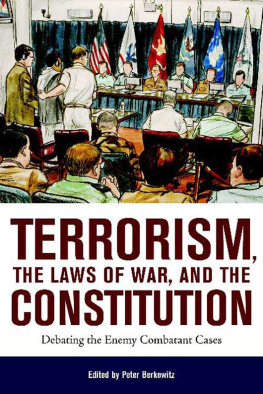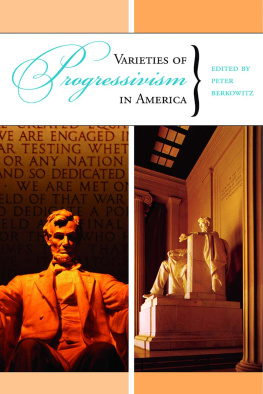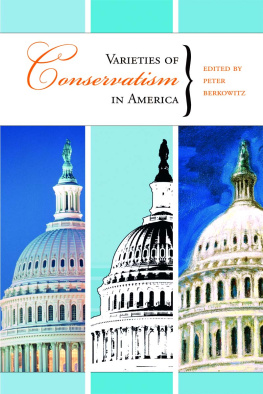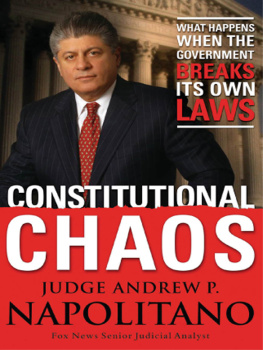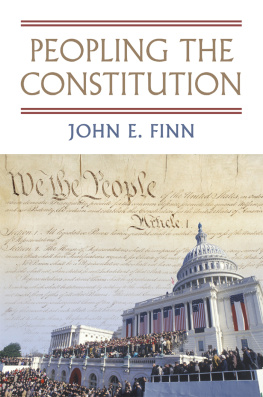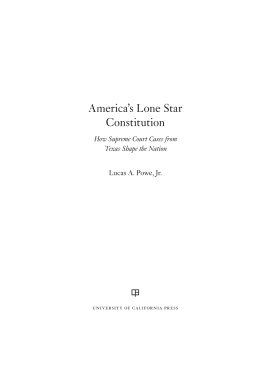Terrorism,
the Laws of War,
and the Constitution
Debating the Enemy Combatant Cases
Edited by Peter Berkowitz
HOOVER INSTITUTION PRESS
Stanford University
Stanford, California
The Hoover Institution on War, Revolution and Peace, founded at Stanford University in 1919 by Herbert Hoover, who went on to become the thirty-first president of the United States, is an interdisciplinary research center for advanced study on domestic and international affairs. The views expressed in its publications are entirely those of the authors and do not necessarily reflect the views of the staff, officers, or Board of Overseers of the Hoover Institution.
www.hoover.org
Hoover Institution Press Publication No. 537
Copyright 2005 by the Board of Trustees of the Leland Stanford Junior University
All rights reserved. No part of this publication may be reproduced, stored in a retrieval system, or transmitted in any form or by any means, electronic, mechanical, photocopying, recording, or otherwise, without written permission of the publisher.
First printing, 2005
12 11 10 09 08 07 06 05 9 8 7 6 5 4 3 2 1
Manufactured in the United States of America
The paper used in this publication meets the minimum requirements of the American National Standard for Information SciencesPermanence of Paper for Printed Library Materials, ANSI Z39.48-1992.
Library of Congress Cataloging-in-Publication Data
Terrorism, the laws of war, and the Constitution : debating the enemy combatant cases / edited by Peter Berkowitz.
p. cm. (Hoover Institution Press publication series ; 537)
Includes bibliographical references and index.
ISBN 0-8179-4622-5 (alk. paper)
ISBN 978-0-81794-623-4 (electronic)
1. Combatants and noncombatantsLegal status, laws, etc.United States. 2. War (International law) 3. Constitutional lawUnited States. 4. Detention of personsUnited States. 5. TerrorismUnited States. 6. War on Terrorism, 2001 7. National securityUnited States. I. Berkowitz, Peter, 1959 II. Series: Hoover Institution Press publication ; 537.
KF7225.T48 2005
343.7301dc22
2005003039
Acknowledgments
The editor is grateful to Jack Goldsmith, who provided valuable comments on several of the chapters, as well as on the Introduction. And it is a pleasure to again thank Hoover Institution director John Raisian and deputy director David Brady for their support.
* * *
The Hoover Institution wishes to acknowledge the generous support of the McCormick Tribune Foundation that made this book possible.
The Institution also wishes to thank supporters of the initiative on National Priorities, International Rivalries, and Global Cooperation, including the Bradley Foundation and Jeronimo and Javier Arango.
Introduction
Peter Berkowitz
AL QAEDAS SEPTEMBER 11 attack on the United States marked the advent of a new era of warfare. Until that awful day, the dominant view held that only a state could threaten another states political sovereignty or territorial integrity. But the destruction of the World Trade Center Towers, the assault on the Pentagon, the attempted strike on the Capitol Building or the White House thwarted by the heroic passengers of flight 91, and the murder of more than 3,000 innocent civilians demonstrated that the dominant view was inadequate. Modern technology had placed in the hands of nonstate actorsshadowy terrorist networks and bands of fanatical thugsthe power to bring a state to its knees.
Like all wars, the global war on terror proclaimed by the Bush administrationor better, the U.S.-led worldwide war against Islamic extremists whose weapon of choice is terrorhas put strain on the rule of law. This is in part because of the ways in which American constitutional law is entangled with the modern laws of war and their long-standing assumption that the principal actors in war are states. The modern laws of war are a part of the law of nations that emerged in the writings of seventeenth- and eighteenth-century jurists and political thinkers and that developed in accordance with the evolving practices of modern nation states. In the aftermath of World War II and the founding of the United Nations, those laws have been a subject of increasingly intense interest and elaboration by international human rights lawyers. Specifying the rights and duties laid down by the laws of war can be difficult, because the laws of war stem from diverse sourcestreaties, customary state practice, and abstract speculation. But the main cause of difficulty today is that the laws of war were developed with a particular conception of war in mindinvolving states with incentives to engage in reciprocal restraintthat does not apply to the conflict with the United States new adversaries. To further complicate matters, although American jurists generally agree that the laws of war are pertinent under the Constitution, they disagree vigorously on how those laws apply. Still, the central challenge for American constitutional law in the war on terror, as for the laws of war more generally, arises from the nature of a new kind of adversary who controls no territory, defends no settled population, hides among and targets noncombatant civilian populations, and seeks to acquire and use weapons of mass destruction.
In spring 2004, the first set of challenges under the Constitution made its way to the U.S. Supreme Court. These challenges came in the form of three cases concerning the process due to detainees who the United States holds as enemy combatantsthose who take up arms and wage war against the United States. All invoked the writ of habeas corpus, the venerable legal means by which a prisoner asks a court to review the legality of his detention. In Rumsfeld v. Padilla (124 S. Ct. 2711 [2004]), the least consequential, the Court declined to consider the merits of the case. Jose Padilla, a U.S. citizen arrested in Chicago in May 2002 on suspicion of involvement in an al Qaeda plot to detonate a dirty bomb in the United States, had been held as an enemy combatant in a military brig in South Carolina without charges, without trial, and without access to a lawyer. In a lawsuit filed in the Southern Districtwhich includes New York, where Padilla was initially detained in federal criminal custodyPadilla contended that in detaining him, the government had violated his constitutional rights. The government responded that the war powers entrusted by the Constitution to the executive branch permitted the president to designate Padilla as an enemy combatant and that such designation overrode the rights to criminal due process that Padilla would otherwise enjoy as a U.S. citizen. Refusing to deal with either argument, Chief Justice William Rehnquists 54 majority opinion ruled that Padilla had filed his petition for review of the grounds of his detention in the wrong federal district and would have to refile in the federal district in which he was detained. Writing for the dissenters, Justice John Paul Stevens would have held that the Southern District had jurisdiction and that Padilla was entitled to a review of his detention there.
In Hamdi v. Rumsfeld (124 S. Ct. 2633 [2004]), the Court did reach the merits. Yaser Esam Hamdi was seized by Coalition forces on the battlefield in Afghanistan in fall 2001. He was brought to the U.S. naval base at Guantanamo Bay, Cuba, for detention as an enemy combatant, but when the army discovered that Hamdi was a U.S. citizen (he was born in Louisiana, but grew up in Saudi Arabia), he was transferred to a military brig in Virginia and was later moved to one in South Carolina. At the time the Court heard his case, Hamdi had been held for more than two years inside the United States without charge, trial, or access to counsel. Hamdis lawyers argued that as a U.S. citizen, he was entitled to the full panoply of protections afforded by the Constitution to those accused of criminal offenses. Justice Sandra Day OConnor wrote for a bare plurality, including Chief Justice Rehnquist, Justice Anthony Kennedy, and Justice Stephen Breyer. She held that Congress had formally authorized the use of military force against al Qaeda and the Taliban, and that under that authorization, the government, as it contended, could detain as an enemy combatant even a U.S. citizen on U.S. soil who had joined the wartime adversary of the United States. But such a designation, she also ruled, did not altogether nullify citizen Hamdis constitutional protections: Hamdi had the right to challenge, with the aid of a lawyer and before a neutral decision maker, his designation as an enemy combatant. Justice David Souters concurring opinion, joined by Justice Ruth Bader Ginsburg, denied that Hamdis detention had been properly authorized by Congress but affirmed the plurality position that Hamdi was entitled to a meaningful review of the governments reasons for detaining him.

